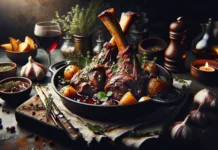The Timeless Allure of Ancient Greek Olives
Welcome to the captivating world of ancient Greek olives, a culinary treasure that was revered in antiquity and remains significant today. These small, remarkable fruits were not merely nourishment; they were symbols of wealth, power, and divine favor. Our exploration of these gifted fruits begins with epityrum, an ancient Mediterranean olive condiment that infuses history with flavor.
A Journey into Olive Civilization
As we delve into the ancient olive civilization, we find that olives played a pivotal role in Greek culture. They held a deep-seated significance in both daily life and mythology, illustrating their importance beyond mere sustenance. During this journey, we will craft a delectable epityrum, a beloved recipe from the ancient world, and uncover the uses of olives in the rich tapestry of Greek history.
Epityrum: The Ancient Dip
Today’s dish, known as epityrum, was widely cherished in the ancient world. In Plautus’s comedy "Miles Gloriosus," a character boasts, “If anyone has seen a greater liar than this guy, he can have me, but I can tell you this: his olives taste divine!” Such quotations affirm the universal appreciation for this olive delicacy.
Recipe Origins
While numerous ancient recipes for epityrum exist, we shall draw inspiration from the Roman author Cato the Elder, whose version closely resembles that of the ancient Greeks. Interestingly, this dish found a home in Sicily, where Greek influences are still prevalent. The preparation of this olive spread is simple yet rich with robust flavors.
Gathering Ingredients
To prepare epityrum, you’ll need a blend of ingredients that vary according to personal taste. For my version, gather two cups (290 grams) of pitted and preserved olives—these could be black, Kalamata, green, or a vibrant mix. In antiquity, green olives were often referred to as white olives—a curious nomenclature with origins that are still debated.
The Key Components
Next on our list is a quarter cup (60 milliliters) of olive oil, two tablespoons (30 milliliters) of red wine vinegar, and a tablespoon of freshly chopped cilantro—or omit it if its flavor doesn’t delight your palate. A dash of ground cumin, chopped fennel leaves, anise, and mint will enhance the complexity of your dish.
Preparation Steps
Begin by ensuring your olives are pitted. Chop them to your desired texture, whether coarse or finely minced. Roman agricultural writer Columella suggests grinding them into a paste if you prefer a modern take. In a bowl, mix together the herbs, vinegar, and oil, then pour this tantalizing blend over the chopped olives.
The Importance of Marinating
Allowing the mixture to marinate for a period enables the diverse flavors to meld beautifully. As it sits, you can take a moment to appreciate the rich history surrounding olives. Did you know that in biblical accounts, an olive leaf signifies the end of the great flood, carried by a dove? Such symbolism beautifully showcases the olive’s prominence throughout history.
Olive Traditions and Discoveries
Evidence of olive cultivation spans back thousands of years, with olive remnants discovered in Egyptian tombs, including the famed wreath found in Tutankhamun’s burial site. The Aegean region’s past is also embroidered with stories of the Mycenaean kings gifting fragrant olive oil jars to Egyptian pharaohs, revealing the interconnectedness of ancient societies.
Myth and Olive Trees
One of the most sacred olive trees belongs to Athena, the goddess who gifted the city of Athens an olive tree in a competition against Poseidon. The olive symbolized prosperity and sustenance—qualities that secured Athena’s position as the protector of the city, which remains significant to this day.
The Goddess and Her Gift
As the tale goes, Poseidon struck the ground in an attempt to present a source of water, but what emerged was saltwater—a less-than-ideal offering. Meanwhile, Athena’s gift of the olive tree proved far more valuable, securing her place as the patron deity of Athens. This legend emphasizes the vital role olives played in ancient Greek society, not only as a food source but as a divine favor.
The Lifespan of Olive Trees
Historically, olive trees in Greece are noted for their longevity. The ancient botanist Theophrastus claimed that Athena’s sacred tree still bore fruit in the 4th century BC, a testament to the resilience and longevity of these magnificent plants.
Legalities Surrounding Olive Trees
There are even ancient legal texts concerning the sanctity of olive trees, with harsh penalties for their destruction. A 5th-century BC defense speech reveals the seriousness with which Athenian citizens regarded the protection of these trees—an olive tree was not merely a plant; it was a divine heritage and communal treasure.
The Versatility of Olives
In ancient Greece, olives were exceptionally valued, not just for their fruits, but also for the wood derived from the olive tree. The Greeks utilized olive wood for shipbuilding, since it was resistant to sea worms, and it was precious for crafting the laurel wreaths awarded to Olympic champions.
Culinary Use and Beyond
Olive oil was considered liquid gold, effectively used in cooking, lighting oil lamps, and crafting perfumes. It adorned the bodies of athletes and served religious rites. Thus, olive oil’s diverse applications established it as one of the most valuable commodities of the time.
A Taste of History
As we prepare to savor our creation of epityrum, it’s essential to recognize its place in culinary history. Pair it with a selection of cheeses—particularly sheep cheese—for a delightful experience reminiscent of ancient banquets. Accompany your tasting with crusty bread, allowing the ancient flavors to transport you back in time.
In conclusion, the exploration of ancient Greek olives not only celebrates a beloved ingredient but also gives voice to stories woven through time. As you craft your own epityrum, remember the rich history behind each olive and the countless generations that have cherished them. Enjoy this culinary journey that embodies the gifts of the gods!





















For behind the scenes banter on Tasting History, casual banter on the channel, videogames, Pokemon, general geekdom, and cats check out our side channel: http://youtube.com/c/ketchupwithmaxandjose .
Also have the 17 episodes up as audio only on Spotify, Apple podcasts, Google podcasts and more. Take a look or a listen and subscribe! 👨🏼🍳
I enjoy the different mascots Max places in the video…like a form of "finding Waldo.' haha.
Back in the old days they had to hang the meet you couldn't you have to eat it fresh or hang it to age it!! It's called meddling meet you ate it hanging!! For at least 7 days!! I thought you knew that but apparently you don't!! If you don't know that then your show sucks!! If you have followers there are a bunch of retards!! Either learn the right way or don't do it at all!! Have a nice day😢
Why don't you try some more ancient beef menus!! Back in the day that they had very few ingredients but what they had they made the best of it and you are not doing a very good job!! Could maybe learn you a lot about cooking but you're !! Your flavor with Mates is not agreeing with me!! Do you know you were gay!!😮😢
Hey Max likes your show but who wants to eat that f**** olive relish s***😢
White wine grapes are not white either
This was a hilarious episode! Thank you!
Its beacuse od translation. You call green grapes green bc they are green, but you dont call the wine from it green wine or yellow wine you call it “white” wine. We call green grapes in croatia white grapes so yea
Actually, they are white olives in some parts of Greece and Sicily
Never watched it, but I know it was filmed in the city I live.
They are like peaches they have fuzz so it looks white also raw olives have a pale greenish gray color
1:48 – white olives
It has to do with how people perceive colors in different cultures in time
Law & Order: Special Olives Unit made me spit out my drink. Thanks Max. A wasted shot of the finest Evan Williams. 🤣🤣🤣
I literally stopped cooking and did a double take at touched by a goat, and said “Della Reese!” Unbelievable. – 30 year old male who also remembers and saw a couple episodes with my mom
GREEKS invented misogyny and slavery worse than in Biblical lands….
Epityrum, or epityron in Greek, literaly means something you put on cheese.
I am so sorry but when i heard you call athena a goddess of fertility its just, no, she was a virgin goddess lol
I like to imagine Pokemon made the Smoliv line because theyre fans of this channel and noticed he didnt have an olive Pokemon plush.
Thanks. Love the video.
Touched by an angel is a euphemism for clergy SA. Or, at least it should be.
Thinking that with a branch of olive tree you can propagate a whole new olive tree, the "olive branch crown" was a great gift!!
I would pair this with a fresh farm cheese, or even cottage cheese, rather than feta, as feta is really salty too.
I make a stuffing for artichokes with chopped olives, olive oil, red wine vinegar, minced garlic, parsley, anchovy chopped, capers and bread …
Thank you. This was very enjoyable 🙂
I can’t explain it, but yea Taillow works. Too bad Smoliv wasn’t here yet
To bad Smoliv wasn't around as a Pokemon for this episode would have been perfect ✨
Green olives called white for the same reason green grapes are called white, perhaps?
just saw this video. and started thinking what you said about the cilantro. i don´t prefer it but usually substitute it with parsley. in my taste those are quite similar taste pallet, but the parsley lacks the soapy taste
As far as pitted or whole olives go, I used to always get whole one because they always tasted fresher and better than the pitted ones. It was worth the effort of removing the stones when cooking with them, used to just cut them in half in a similar way to avocados, and just roll the stone out (kind of, sometimes it was more attached than others).
Man it must have been a challenge living in ancient Greece if you didnt like olives. I for one genuinely despise olives. Its gross beyond compare for some reason.
I think they were called white olives because they look white on the tree.
There's a movie called The oil of Lorenzo with Susan Sarandon and Nick Nolte. Amazing movie and true story.
Home-made garlic bread, cream cheese, and a beer. She'd be good, bro
I used to love touched by an angel.
Anointing with oil was so important that the Hebrew word messiah and the Greek translation, Christ, mean "anointed one."
Black olives have been oxidised. Opposite to black is White.
Awesome information and great recipe and video Thanks 👍
The term "white olives" used by the Ancients to refer to what we now call green olives likely stems from the appearance of these olives when they are unripe. In their early stages, green olives have a lighter, sometimes whitish or pale green hue. This lighter color could have prompted the term "white" to describe their appearance.
In ancient texts, terminologies were often based on visual characteristics that might differ slightly from modern perceptions. Thus, the term "white olives" was likely a descriptive term based on the visual appearance of the unripe olives, which can appear very pale or whitish compared to the dark, fully ripe olives.
You get the thumbs up from me for including Monty Python ( as well as the olive stuff 😉 ) .Well done .
white in their meaning probably meant lighter and black darker
I love your Taillow perfect choice for an olive episode!
I'm pretty sure it is in fact not pronounced "epitairum" since ancient Greeks weren't speaking English.
Too many references to other shows in this one, Max. You're trying too hard.
The Monty Python reference was gold, thank you!
Olive Tapenade is delicious on sourdough bread.
I was listening until holey grail reference lol 😂